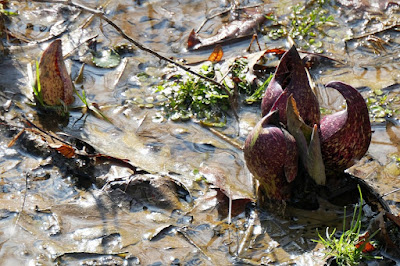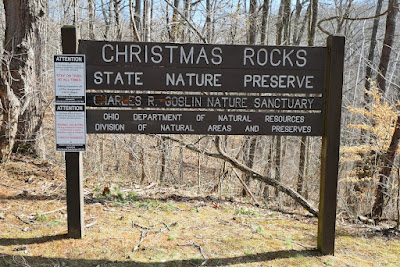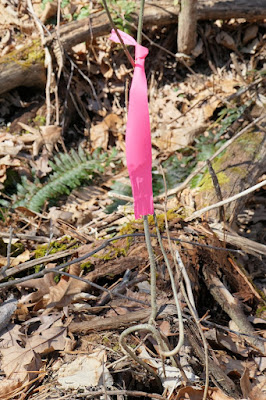On March 10th Joan and I drove down to Christmas Rocks State Nature Preserve. The morning was chilly but bright and promised to warm up quickly.
We hiked along the low-lying stretch of gravel road between the parking area and a chunk of private property enclosed within the preserve,
and soon were thrilled to observe a meadow of skunk cabbages emerging from the boggy area on our right.Skunk cabbage is a thermogenic plant: it generates heat to thaw frozen ground and melt snow and ice as it sprouts. It also emits a foul odor that attracts pollinators. (The male and female parts of a skunk cabbage mature at different times, avoiding self-pollination.) In this photo a cabbage has split open to reveal the flower cluster within.

 |
Photo from February 2016
|
into the preserve. At junction C we began the steepest climb of the route, up to a sandstone promontory.The trail climbs to the left and then takes a right turn. Here's a photo from the lookout. |
This one's also from February 2016
|
After wandering and descending to intersection D, the main trail, we soon reached the spot where an old road crossed the creek. Depending on how high the water is, you can cross partway or entirely on stones and slabs. Looking upstream ...Pause to look at your feet and observe the ripples.Joan and I then followed the trail past intersection E and climbed up the ridge at the furthest extent of the blue loop. Along the way we encountered the leaves of an orchid, the rattlesnake plantain.After completing the blue loop, we turned around and traversed it clockwise rather than counter-clockwise. Things always look different, or even choose to reveal themselves, when we hike in the other direction.A massive fungus is giving this tree a beard.
A closeup.
This tree has been a woodpecker restaurant.
On our return we reached the gravel stretch and then passed the house, thinking we were about done. We weren't. A burbling din filled the air when the came around the curve. Wood frogs. |
Click on the image to enlarge.
|
Lots of wood frogs.We had hit the magic time when these woods-dwelling frogs emerge from hibernation and seek ephemeral pools to breed. The day had warmed enough since Joan and I arrived to draw them out.And the sound and hopping about ...
Joan and I were extremely lucky to have picked Christmas Rocks on this particular day.






























